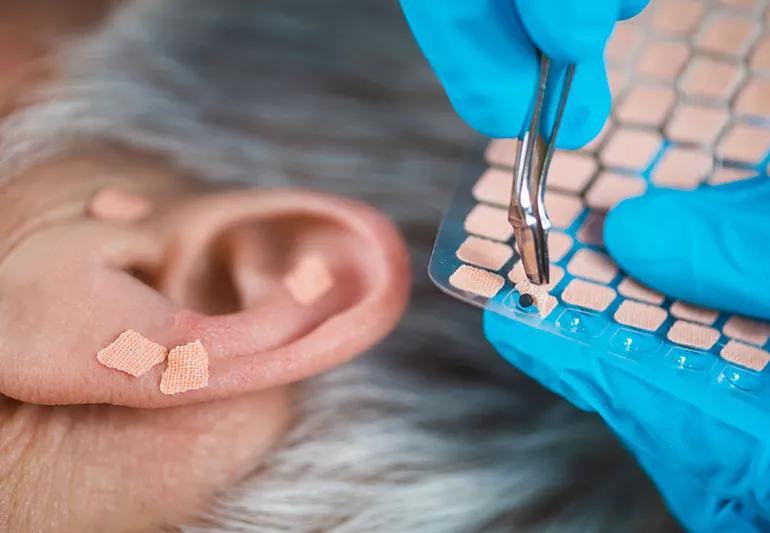An acupuncturist explains how they can help promote symptom relief

Ear seeds are everywhere these days. And though the name may call to mind visions of flowering plants sprouting from your earlobes, they’re actually a form of acupressure, which targets acupuncture points without using needles.
Advertisement
Cleveland Clinic is a non-profit academic medical center. Advertising on our site helps support our mission. We do not endorse non-Cleveland Clinic products or services. Policy
So what can these tiny but mighty acupressure tools do for you? Acupuncturist Thuy Kim Nguyen, DAOM, LAc, explains what ear seeds are, what they do and how to use them for the most benefit.
Based in traditional Chinese medicine (TCM), ear seeds are a form of auriculotherapy, which uses acupressure points in the ear to stimulate other parts of the body.
“Auriculotherapy is commonly used in traditional Chinese medicine to treat and even prevent conditions like anxiety, insomnia, chronic pain, nausea, vomiting, substance abuse and gynecological and digestive disorders,” Dr. Nguyen says. “The ear seed is like an acupuncture needle that you use to stimulate a channel to help the patient’s condition without needing to puncture the skin.”
So what exactly is an ear seed? They’re small latex stickers — about the size of a fingernail — that contain a ripe seed from the Vaccaria plant. Your acupuncturist places each ear seed carefully on your ear in specific acupressure points that correspond with the conditions you’re experiencing.
“The ears reflect the condition of the internal organs,” Dr. Nguyen says, “so bodily problems will show on the ears. Certain points on the ear change in color, become tender or exhibit changes in size or shape. We use those signs to figure out where to put the seeds to help the patient.”
Advertisement
The most commonly used ear seeds are made from Vaccaria seeds that are attached to an adhesive sticker, though some versions now are made with ion pellets, magnets, stainless steel, titanium, ceramic or other materials instead.
If you have allergies to latex, bandages or tape, make sure to consult with your acupuncturist to use ear seeds with a backing that’s safe for you.
There’s not enough research to prove how well ear seeds work, but studies continue showing that they have a positive impact on insomnia and pain — and maybe on other conditions, too.
“There are more than 120 acupressure points in the ear,” Dr. Nguyen says. “The ears have a very close relationship with the nervous system, and some research shows that acupuncture or acupressure on the ear can stimulate the meridians.” (According to traditional Chinese medicine, 12 primary meridians carry energy throughout the body.)
Ear seeds, then, can be used to address a variety of health concerns, including:
Thinking about trying ear seeds on your own? Dr. Nguyen explains how to get started and why you should see an acupuncturist beforehand.
Although ear seeds are sold for use at home, Dr. Nguyen recommends first consulting with a licensed acupuncturist to make sure you’re putting them in the right place for your specific needs.
“It’s important that you always consult with your practitioner or your primary care provider first to see if this is something you should be doing and to make sure it’s safe for your condition,” she says.
Three to five times per day, gently rub your ear seeds in a circular motion to stimulate the parts of your body they’re intended to help.
“Don’t press down too hard, to the point that you hurt yourself,” Dr. Nguyen says, “but just enough that you can feel the stimulation.”
Your ear seeds will lose their stickiness with time, especially as they’re exposed to the moisture in the air and water when you shower. And even if they’re holding up well, you should remove them after a few days so they don’t start to irritate your skin.
After an acupuncturist has shown you where — exactly — to apply your ear seeds for the most benefits, you can try at-home application.
But Dr. Nguyen says it’s best to have someone else apply them for you using tweezers. This will ensure that the ear seeds are applied in the right spot and lessen the risk of the seed coming off of its sticker and falling into your ear canal.
Advertisement
Ears seeds are generally safe to use, but there are some risks. Adverse reactions may include:
The best way to make sure you’re using ear seeds safely is to talk to an acupuncturist before using them on your own.
Advertisement
“If you want to use ear seeds, it’s very important that you first consult with a practitioner so that they can show you where to put them and where to avoid using them,” Dr. Nguyen reiterates.
Advertisement
Learn more about our editorial process.
Advertisement

There’s very little scientific evidence that this alternative medicine practice works

This traditional Chinese medicine practice may boost mental health, immune function, balance and more

This ancient form of exercise can offer a physical and mental boost

Many claims lack science-backed research, but halotherapy is popular and considered safe

This five-day exercise plan for beginners includes three days of resistance training, two days of cardio and two days of rest

If you don’t have an underlying condition, cold plunges might help ease sore muscles, decrease inflammation and even heighten your focus

This purple perennial has many uses, including sleep hygiene, reducing inflammation and pain, and elevating mood

The nocebo effect is a phenomenon where expectations of negative outcomes may influence the results

Babies can get congested easily, but you can calm their cough by keeping them hydrated, using nasal drops and running a humidifier

Weight loss may cause loose, sagging skin and muscle loss to your rear

Several conditions, like vitiligo and fungal infection, can cause a loss of pigmentation, leading to white spots or patches on your skin